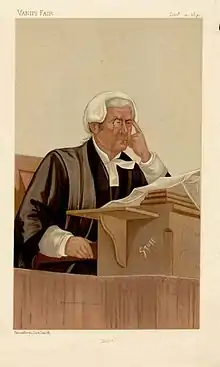Robert Romer
Sir Robert Romer GCB PC FRS (23 December 1840 – 19 March 1918) was a British judge. He was a High Court judge 1890-1899, and a Lord Justice of Appeal 1899-1906 when he was known as Lord Justice Romer.

Biography
Romer was born in Kilburn, Middlesex.[1] He attended St John's School, Leatherhead (in Surrey) and excelled at mathematics at Trinity Hall, Cambridge where he was Senior Wrangler in 1863 (the first from Trinity Hall) and was joint winner of Smith's Prize in that year.[2] Following the premature late 1864 death of George Boole, the first professor of maths at Queen's College, Cork, Romer beat out Robert Ball for the vacant position, however he only stayed in Cork for 1865-1866.[3] He became QC in 1881, and a bencher of Lincoln's Inn in 1884.[4] The same year he unsuccessfully stood as the Liberal candidate in Brighton.
In 1890 he was appointed High Court judge and assigned to the Chancery Division, receiving the customary knighthood. He served as such until 1899, when he was appointed a Lord Justice of Appeal, in succession to Chitty. He resigned in 1906.
Romer was sworn a Privy Councillor in 1899, and elected a Fellow of the Royal Society in the same year. He was appointed Knight Grand Cross of the Order of the Bath (GCB) in the New Year Honours list 1 January 1901,[5] and was invested by King Edward VII in February the same year.[6]
He was a member of the Royal Commission on South African Hospitals in 1901, during the Boer War.[7] He was a member of the Royal Commission on University Education in London in 1909.[8]
Family
In 1864 he married his first cousin Betty Lemon, daughter of his aunt Helen (Nelly) Romer and Mark Lemon, editor of Punch. Their sons were Mark Romer, Baron Romer and Sir Cecil Romer.[9] His grandson Sir Charles Robert Romer was also Lord Justice of Appeal.[10] Their daughter Helen Mary married future Lord Chancellor Frederic Maugham.
Arms
|
References
- Romer, Sir Robert Oxford Dictionary of National Biography
- St John's School, Leatherhead. School Register 1852-1904
- Reminiscences and Letters of Sir Robert Ball Edited By W. Vaihntine Ball
- Robert Romer ACAD: A Cambridge Alumni Database from 1200 to 1900
- "No. 27264". The London Gazette. 8 January 1901. p. 157.
- "Court Circular". The Times (36378). London. 14 February 1901. p. 6.
- "The Royal Commission on South African Hospitals". British Medical Journal. 1 (2091): 236–240. 1901. doi:10.1136/bmj.1.2091.236. PMC 2400194.
- "Thomas Carlyle Parkinson, M.D. (Sydney)". British Medical Journal. 1 (2513): 574. 1909. doi:10.1136/bmj.1.2513.574. PMC 2318341.
- "Obituary: Sir Cecil Romer – Hard Fighting in France". The Times. The Times Digital Archive. 3 October 1962. p. 13.
- "Obituary: Sir Charles Romer – Former Lord Justice of Appeal who headed Portland committee". The Times. The Times Digital Archive. 17 February 1969. p. 10.
- "Lincoln's Inn heraldic panel". Baz Manning. Retrieved 16 May 2020.
External links
 "Romer, Sir_Robert". Encyclopædia Britannica. 32 (12th ed.). 1922. pp. 289–290.
"Romer, Sir_Robert". Encyclopædia Britannica. 32 (12th ed.). 1922. pp. 289–290.- "Romer, Robert (RMR859R)". A Cambridge Alumni Database. University of Cambridge.
- MacKinnon, Frank Douglas; Polden, Patrick (2004). "Romer, Sir Robert (1840–1918)". Oxford Dictionary of National Biography (online ed.). Oxford University Press. doi:10.1093/ref:odnb/35819. (Subscription or UK public library membership required.)